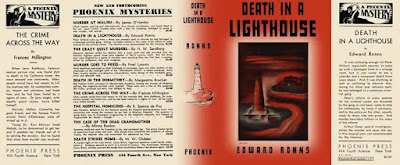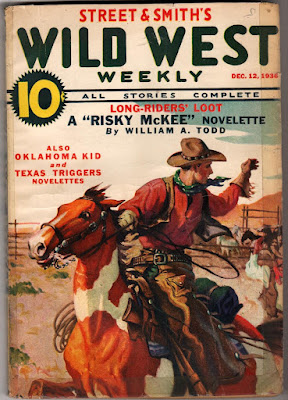Young cowboy Jim Delaney finds himself falling in with some bad company in the brush country between San Antonio and the Rio Grande. He’s not exactly an owlhoot and a rustler yet, but he’s drifting in that direction. Then he rides into San Antonio to see the elephant (a cowboy term for having some new experiences, for those of you unfamiliar with the term) and winds up rescuing a beautiful girl from the clutches of an evil gambler and saloonkeeper. This lands Jim right in the middle of a deadly feud between the Gliddens, an outlaw family, and upstanding cattleman Pike Corcoran and his family and friends. Jim will have to figure out which side of the trail he’s going to ride.
That pretty much sums up the plot of RUN OF THE BRUSH, a 1936 Western novel by William MacLeod Raine, one of the early stars in the genre who continued writing Westerns until his death in 1954. This novel was serialized in SHORT STORIES in January and February 1936 before being published in hardcover by Houghton Mifflin. That's my copy of the Seventies paperback and the edition I read in the scan above.
Born in England but raised from the
age of 10 in the western United States, Raine published more than 80 novels, most
of them Westerns with a few historical and contemporary novels mixed in. I’ve
read maybe half a dozen of his books and enjoyed them, although with some reservations.
RUN OF THE BRUSH, from just past the halfway point in his career, continues
that streak.
Raine’s novels often contain characters and incidents loosely based on history.
The reformed outlaw King Cooper in this novel is pretty clearly based on the
historical character King Fisher, but Cooper’s involvement in the plot is
strictly fictional. The notion of a feud with numerous deaths on both sides is
common in Texas history, of course. I don’t know if the conflict between the Gliddens
and Corcorans in this book is based on a specific feud, but it certainly has an
air of authenticity about it, as do the ways Raine’s characters speak and act.
The man knew the West, there’s no doubt about that.
However, despite the fact that there are some great action scenes in this book
(the final battle verges on epic but doesn’t quite get there), there are long
stretches that are very leisurely paced. Well-written, amusing at times, with
good characters, but slow to get through. There’s also a romantic triangle, and
I’ll just go ahead and say it, Jim Delaney picks the wrong girl. Another
thing that bothered me is that Jim is also known as Slim, and one of the main
villains is named Sim. That’s not very good character-naming.
So overall, there’s enough to like about this novel that I’m glad I read it,
and if you don’t mind a Western yarn that takes its time about getting where it’s
going, I’d recommend it and anything else written by William MacLeod Raine. I’ll
probably continue reading one of his books every now and then. I don’t think he’ll
ever be one of my favorite Western authors, though.
































